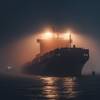Interview: Jim McCarville, Executive Director, Port of Pittsburgh
Jim McCarville, Executive Director, Port of Pittsburgh shares with readers of MarineLink.com his insights on key market drivers for the coming year.
If you could change or improve one policy in the federal government that affects your business's bottom line, what would it be?
JM: The federal government, unfortunately, looks at transportation projects as stovepipes, failing to grasp that a decision to make or not make waterway improvements will impact other modes of transportation. Failure to improve the waterways in a timely fashion has added roadway congestion, increased roadway repairs and accidents and added automotive air pollution as well.A recent study for the U.S. Maritime Administration and Waterways Council, Inc., done by the Texas Transportation Institute, showed that each fifteen barge tow can take 1,050 trucks off of the roadways. While the towboats can move a ton of cargo 576 miles on a gallon of diesel, trucks can move it only 155 miles, and trucks emit three times the level of CO.As a nation it is increasingly more difficult to add road capacity or even rail trackage in the eastern half of the US, but there is significant room to add waterway capacity by modernizing our locks and dams. In Pittsburgh we have three sets of locks on the Upper Ohio River that are way past the time they should have been modernized. The size of those locks are the smallest on the Ohio River, cause towing companies to break up the efficiency of large tows in order to transit the locks, adding time and cost to consumers. The USACE has started a study of these locks, and we have some indication that they may consider the roadway congestion impacts in their decision to replace them or not, but we would like to see it written into policy, as well as including considerations of environmental and safety factors in the decision to make or not make the needed improvements to the waterway system.
What legislative/political issue do you count as the most important for the marine industry in the next few years?
JM: The timely rehabilitation of our nation's locks and dams stands out as the most important marine priority. In Pittsburgh, the USACE has a project on the Lower Monongahela River to rehabilitate three locks and dams. They started in 1994 and were scheduled for completion in 2004. Due to inadequate funding and rising costs, they now project a completion date in 2016, 2019 or some time beyond. The failure to complete on time has already cost a loss of over $1.2 billion in economic benefits that cannot be regained. According to an independent consultant, that project was expected to add 8,800 jobs to the Mon Valley, a very depressed part of the nation. We are still waiting for those benefits and those jobs.
Since the project was authorized, the waterway industry, through the 20 cent a gallon marine diesel fuel tax, has been paying into a fund that was adequate to pay its 50% share of the cost. The Administration is proposing to tax the industry again for this project, through a new lockage fee (read tax) without fixing the problem. Since industry has already paid its share into this fund over the past fifteen years, maybe the government needs to complete this project, and many similar ones like it, before levying any new (taxes) fees.
Where is your company investing today to build a better future?
JM: The Port of Pittsburgh Commission (PPC) is in the business of maximizing the economic benefit the waterways can provide for this region. Early out it identified a gap in research and technology. We recognize that the towing industry actively promotes R&T for its own purposes and that the USACE does the same for its purposes. The gap occurs in the communications and technologies that bridge between the two worlds. Two specific problems were the time lost due to low visibility and the problematic transmission of accurate data between the vessel and the lock.
Working with the full cooperation of the Campbell Transportation Company, the Pittsburgh District of the USACE and Carnegie Mellon University student, the PPC developed and was eventually granted a patent on a virtual navigation system, called SmartLock, to aid in lock transits during low visibility. Using the same team, but different students, we also completed a diagnostic of all of the communications between the tow boats, towing companies and USACE regarding the lock transit communications.
The challenge ahead is to continue to work with these two institutional worlds to implement these time and labor saving technologies into daily life on the river.
(Source: MarineNews, June 2008 edition, "CEO Six-Pack")











